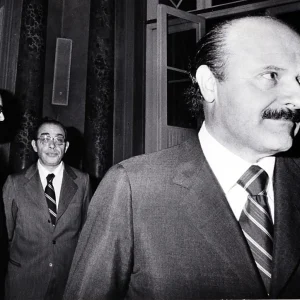In July 1987, 38 years ago this week, a Nazi war criminal, the “Butcher of Lyon”, was sentenced to life in prison by a French court for crimes against humanity. Four years earlier, in 1983, the BBC reported on how France felt about this reckoning with its dark past.
Klaus Barbie was known as the “Butcher of Lyon”. As the Gestapo chief in Lyon, France, during World War Two, he had been tasked with shattering the French Resistance and ridding the German-occupied city of its Jewish population. He became notorious for his cruelty and sadism, often taking a personal role in torturing and killing prisoners. He sent some 7,500 French Jews and Resistance fighters to concentration camps and executed 4,000 more.
Warning: This article contains details of torture that some may find upsetting.
When the war ended, despite being wanted by French authorities for his horrific war crimes, he was hired by US intelligence as an informant on communist networks. They shielded him, allowing him to live in the US zone of occupied Germany under a false identity. In 1951, Barbie managed to escape prosecution by fleeing to South America via “The Ratline” that the US used to smuggle Nazis out of postwar Europe. He lived openly in Bolivia for decades until he was tracked down by a Nazi-hunting couple, Serge Klarsfeld and his wife Beate. In 1983, France finally managed to extradite him to face justice. And in July 1987, 38 years ago this week, he was finally sentenced to life in prison.
But Barbie’s prosecution was far from a straightforward matter for France. The Nazi’s return raised questions of guilt and complicity, focusing the nation’s attention on the choices its citizens had made while living under German occupation. In 1983, four years before Barbie was sentenced, BBC reporter Bernard Falk travelled to Lyon to talk to people “whose lives were touched by the Gestapo commander’s savagery” and the complicated and painful issues the forthcoming Barbie trial had resurfaced.
“The presence of Klaus Barbie back on French soil has also aroused genuine fear that it may evoke old memories, the ghosts of 40 years ago,” said Falk. “A time when Frenchmen betrayed Frenchmen and the country was divided into those who fought the Germans, the Resistance, and those who collaborated with them, and the bulk of the population who passively accepted their presence.”
Resistance fighter Raymond Basset reflected on this legacy: “At the time of the liberation of Lyon, there were about 6,000 members of the Resistance movement in the area. Three days afterwards, there was 110,000. That probably explains a lot of things about French life today. Why? Because they only became patriots when there is no more risk attached to it. That’s all.”
When France surrendered to Germany in June 1940, the city of Lyon became a centre for the underground Resistance movement. Basset and radio operator Marcel Bidault were two of the young men who joined early to fight the Nazi occupation. “Basset ran a Resistance group responsible for smuggling shot-down Allied airmen across the Pyrenees to Spain,” said Falk. “Four thousand British, American and Commonwealth servicemen owe their lives to Basset’s unit.”
But for every person who actively resisted the Nazis, many more tried to keep their heads down, hoping they would survive. Meanwhile, others welcomed the Nazis, even forming militia to participate as they terrorised the city’s residents. Basset discovered this firsthand when he was arrested and then brutally interrogated while having his teeth pulled out. “Captured by the Gestapo, he was tortured to reveal the names of his couriers,” said Falk. “The two men who mutilated him were both Frenchmen working for the Germans.” Basset’s co-conspirator, Bidault, “was captured by the French militia collaborating with the Nazis. He escaped before his own countrymen could hand him over to the Gestapo.”
Following France’s liberation in 1944, people thought to be French collaborators were rounded up. Many were publicly humiliated. Women who had consorted with German soldiers had their heads shaved or were stripped and daubed with tar. People who had cooperated with the Gestapo were beaten in the streets, and some were tried and shot, including the men who had brutalised Basset. “I killed them, of course, we killed them at the liberation, there is no point in giving you their names,” the 75-year-old Basset told the BBC in 1983. “They had retired with vast quantities of money, stolen from the Jews.”
Naming the collaborators
But in the decades since the war, the German occupation and the scars it had created within French society had not been forgotten. Many of Lyon’s residents were still haunted by what had happened during that time. “For the old, for those who suffered, Barbie never really went away. It’s all still here. The battleground where the Resistance fought the occupying German army through the alleyways of the old city. The same streets, the same buildings,” said Falk.
With the “Butcher of Lyon” back in the country for trial, Basset was keen that France should acknowledge and reckon with its past. He told the BBC that the Gestapo chief should be made to name the French people who collaborated with the Nazis and escaped judgement. “I think the interrogation of Barbie will create many problems because there are most certainly men who were implicated with him,” said Basset. He also told Falk of his desire for revenge. He wished that he had a chance to interrogate Barbie, and to mete out the punishment that he had suffered.
In particular, the survivors wanted to know “the name of the person who betrayed Jean Moulin, the greatest of all the French Resistance leaders, who was arrested in Lyon after a tip-off”, said Falk. Moulin was a crucial figure during the war who united the scattered elements of resistance into a co-ordinated force against their Nazi occupiers. He was viciously tortured by Barbie and died as a result of his injuries on 8 July 1943 on a train taking him to Germany.




